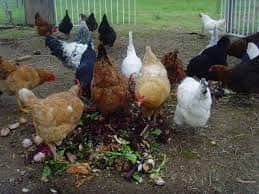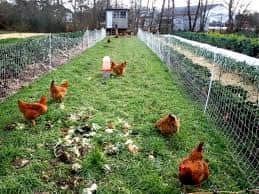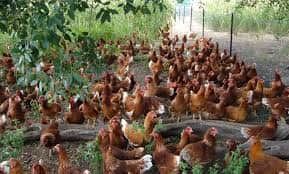CONCEPT OF ORGANIC POULTRY PRODUCTION IN INDIA
Dr Surinder Khanna, Poultry consultant, Chandigarh
INTRODUCTION
In recent days there has been an increased health concern over quality of milk, meat and egg products due to the presence of various pesticides, insecticide, chemicals, drugs and hormone residues. Due to this organic livestock farming is increasing at rapid pace worldwide with faster growth in demand of organic milk, meat and eggs products. Organic livestock farming is most suitable to our Indian conditions because of indigenous technical knowledge and practices followed by Indian farmers. In order to make organic livestock and poultry farming successful there is a need to take care of certain issues, like health management, record keeping, breeding strategies, certification, cost of production and cost of inputs etc. Increased consumer awareness of food safety issues and environmental concerns has contributed to the growth in organic farming over the last few years, although it only represented around 3 per cent of the total agricultural area.
Now-a-days quality and health conscious consumers are increasing and they need environmentally safe, chemical residue-free healthy foods, along with product traceability and a high standard of animal welfare. These can be ensured by organic production methods. Organic farming can provide quality food without adversely affecting the soil health and the environment. Organic livestock farming should not necessarily
be interpreted to mean that the foods produced are healthier, safer or all natural. It simply means that the products follow the defined standard of production and handling, although surveys indicate that consumers consider the organic label as an indication of purity and careful handling. In order to make organic livestock farming a success, there is need to take care of certain points, like reducing the paper work and cost for certification; sourcing of organic inputs like feeds and fodder, disease prevention, cost of production and maintaining animal health etc.
FAO defines Organic farming as “ a unique production management system which promotes and enhances agroecosystem health, including biodiversity, biological cycles and soil biological activity, and this is accomplished by using on farm agronomic, biological and mechanical methods in exclusion of all synthetic off farm inputs.”
That means ORGANIC POULTRY is Rearing of birds without cages ,Outdoor access ,Organic feed with Natural treatments .
Basic requirements for organic poultry and dairy include ——
a. Appropriate housing that permits natural behaviour, including outdoor access
b. Certified organic feed, including pasture
c. No antibiotics, drugs or synthetic parasiticides
d. Organic processing of meat and eggs
e. Recordkeeping system to allow tracking of poultry and products (audit trail)
f. Organic system plan including description of practices to prevent contamination, monitoring practices and list of inputs
g. Production that does not contribute to contamination of soil or water
h. No genetically modified organisms, ionizing radiation or sewage sludge
i. Pasture management
j. Grazing management
k. Stress management
l. Dry cow management, or a dry cow program
m. Seasonal breeding
n. Access to the environment.
o. Access to the pasture.
p. Natural maintenance of shelter.
q. Avoidance of synthetic substances.
r. Rearing of birds without cages
s. Outdoor access
t. Organic feed
u. Natural treatments
Breeding——
The choice of breeds of poultry should be based on their adaptability to the local conditions. Breeding goals should not be contrary to the animal behaviour and should be directed towards good health. The use of genetically engineered species or breeds is not allowed for organic farming. Reproductive techniques should be natural and hormonal treatment for better egg production is contraindicated. The sex ratio should be one male for about 4-6 hens in a flock like in case of the wild birds.
Housing——
The birds should be housed in such a way as to provide opportunity for the bird to exhibit all its normal behaviour patterns and experience minimal stress. Cages should be avoided and birds should be reared under deep litter system. They must have easy access to an outside grazing area, fresh air, clean water, balanced ration, dust bathing facilities and an area for scratching. Debeaking and beak trimming are usually prohibited practices but some certifying agencies still permit Debeaking if done more than 5mm of the upper beak should not be removed (Chander et.al 2006). In the organic meat sector birds must be grown for a period of 81 days of age usually.
Feeding-——
Birds should be fed 100 per cent organically grown feed of good quality. All ingredients must be certified as organic, except vitamin and mineral supplements making up to 5 per cent of the diet. The diet should be offered in a form so that the birds can exhibit natural feeding behaviour and digestive needs. Concentrated balanced feed ration produced organically should be given. The largest component of any organic poultry diet is maize and high quality roughages, particularly legumes can be supplemented to the diet. Home grown protein sources like peas, beans and rapeseed can also be utilized. Peas can be included at the rate of 250-300g/kg for the table chicken and 150-200g/kg for laying hens. Since sprouted pulses are a good source of vitamins they can be preferentially used to replace synthetic amino acids. Limestone and rock phosphate in general and limestone grit and rock phosphate particularly for layers can be included as mineral source. Trace minerals incorporated in the diets should be organic or ayurvedic in nature. The quota of essential amino acids can be met through feeding organic soybean, skim milk powder, potato protein, maize gluten etc. Nevertheless, balanced ration should be given and overfeeding must be avoided.
A continuous access and ample supply of drinking standard quality water free from residues should be assured. Water should be regularly tested for ground water contamination.
Feed used for organic poultry production must not contain:
1. Animal drugs, including hormones, to promote growth;
2. Feed supplements or additives in amounts above those needed for adequate nutrition and health maintenance;
3. Plastic feed pellets;
4. Urea or manure;
5. Mammalian or poultry slaughter byproducts fed to mammals or poultry;
6. Feed, additives, or supplements in violation of the Food and Drug Administration; or
7. Feed or forage to which any antibiotic, including ionophores, has been added.
BREEDS & VARITIES —–
INDIGENOUS BREEDS ——-Kadaknath ,Nicobarifowls,aseel
DEVELOPED VARITIES ——-Giriraja – From a broiler breeding programme white plymoth rock,red cornish,new hampshire Vanaraja- PDP , 1998 Red cornish lines Gramapriya- white leghorn female line, egg production,tanduri meat. CARI-Gold- RIR ♂ X WL ♀
KRISHIBRO VANARAJA
SWARNADARA HITCARI
UPCARI CARI-SHYAMA
NIRBHEEK CARI RAJASRI
TREATMENT ——Vaccines are allowed. *Probiotics are often used. *Antibiotics treatment is must not be with held if birds need *these birds are diverted in to non organic markets….
PARASITICIDES ——Synthetic paracitides, *anticoccidials *Pyrethrum for mite ,garlics, *linseed oils,turmeric
LITTER MANAGEMENT ——-Allow the bird to eat if litter is organic but most poultry litter are not. **Moisture controller like sodium bisufite are not allowed ***Hydrated lyme can be used ***Don’t allow the birds to graze in crops that are to be harvested within 90 days.
PREDATOR & RODENT CONTROL ——Poultry should be protected from predators both indoors and out doors **Electric fences for outdoor and indoor. ***rodents – habitat reduction and physical exclusion from facilities and feed ***Mechanical and physical methods traps, electric fences adhesives and fans. ***cholecalciferol&sulfur dioxide as an underground smoke bomb.
Health Care:———-
The principle of healthcare and management in the organic farming concept is that when all management practices are directed towards the well being of the birds they will achieve maximum resistance against diseases and overcome many infections. Clean grazing and dry litter would ensure prevention of almost all health related problems. Use of antibiotics should be avoided; however vaccinations are permitted only when diseases are expected to be a problem. Use of natural medicines and homeopathy and ayurveda should be encouraged.
organic poultry producers must establish preventative health care practices, including:
1. Selection of species and types of poultry that are suitable for site-specific conditions and resistant to prevalent diseases and parasites;
2. Provision of a feed ration sufficient to meet nutritional requirements, including vitamins, minerals, protein and/or amino acids, fatty acids, and energy sources;
3. Establishment of appropriate housing, pasture conditions, and sanitation practices to minimize the occurrence and spread of diseases and parasites;
4. Conditions that allow for exercise, freedom of movement, and reduction of stress appropriate to the species (no caged laying hens, for example);
5. Physical alterations as needed to promote the poultry’s welfare, performed in a manner that minimizes pain and stress; and
6. Administration of vaccines and other veterinary biologics.
Record Keeping:——–
Record keeping with respect to the overall management practices is the most important factor. It should be systematic documentation of activities, observations and inferences from time to time for future reference. Records include breeding records, registers indicating source of animals purchase, source of organic feed ingredients, feed supplements and feed additives purchased, organic feed formulation record, organic poultry pasture record, inventory of health care products, sanitation products, monthly flock records of organic egg layers, organic meat poultry, organic poultry slaughter/sales summary and monthly organic egg packing /sales record.
TEN REASONS TO BUY ORGANIC POULTRY & DAIRY
1.Free of antibiotics, added hormones, GMO feed and other drugs; no GMO animals:
Animals raised organically are not allowed to be fed antibiotics, the bovine human growth hormone (rbGH), or other artificial drugs. Animals are also not allowed to eat genetically modified foods. Further, animal products certified as organic can’t have their genes modified (for example, a scorpion gene cannot be spliced into a cow gene).
2. Mad cow safeguard: Animals aren’t forced to be cannibals
The practice of feeding cattle the ground up remains of their same species appears to cause bovine spongiform encephalopathy, a horrific disease that destroys the central nervous system and brain, can be given to humans who eat the cows. The disease in humans has a very long latency period, and is called Creutzfeld-Jakob disease.
3. More humane, ethical treatment of animals
Factory farms treat animals like commodities, and they are kept in tightly confined pens and often never move more than a few feet their whole lives.
4. Animals free-range and graze
The words “free-range,” and “ranch raised” are clues that the animals were raised in a more humane way. Their diet tends to be more well-rounded; the animals are not confined and spend time outdoors in the fresh air.
5. Manure
Small farms use it, industrial farms pollute with it.
6. Animals are integral to small farms
Using animal manure is considered recycling of nutrients. No farm can cope with all the animal offspring, so selling some makes economic sense. Sustainable farms tend to provide and sell a range of products, and organic eggs and animal products would be included.
7. Fewer chemicals used
Synthetic pesticides and fertilizers are not used on the food or land. Residues of persistent chemicals such as DDT, PCBs, dioxin, and many pesticides concentrate in animal fat. Eating organic animal fat reduces your exposure to these chemicals.
Farmers working on organic farms are exposed to fewer chemicals.
8. Diversity
Industrial farms rely on just a few species of cattle, chickens, pigs, etc., whereas small sustainable farms tend to raise a wider variety of livestock. Entire species of livestock can die out if they are not raised on farms.
9. Factory farms use huge amounts of resources
The factory farm industry is run with cheap, nonrenewable fossil fuel. Producing, transporting, processing, and marketing the food all depend heavily on it. Without cheap fuel, industrial agriculture would be impossible because it would be too expensive, notes organic farming expert Fred Kirschenmann. The heavy pesticide use on industrial farms contaminates groundwater and soil. Kirschenmann believes industrial farms are responsible for the loss of over half ofU.S. topsoil.
10. Your money support the farm you buy from
If you buy your meat from an organic farmstand at a farmer’s market you support that farm. On the other hand, if you buy non-organic meat that isn’t local, free-range, or ranch-raised from a supermarket chain, you most likely support a multinational food conglomerate.
Constraints of organic poultry & dairy farming in India
1.Lack of knowledge and awareness among consumers at the production and marketing level
2.Inadequate financial support, inadequate local certifying agencies and lack of marketing channels
3.Training facilities for poultry & dairy farmers are not adequate
Conclusion
Livestock revolution aims not merely to increase the production but to improve food security and safety of consumers .India has a tremendous potential for organic animal production and the ill effects of conventional farming are compelling the consumer to shift to the organic food products.



Reference:On request


